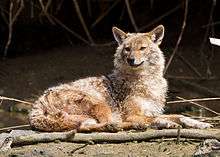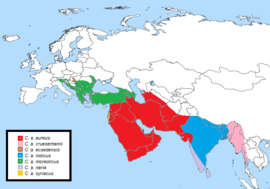Syrian jackal
| Syrian jackal | |
|---|---|
 | |
| Scientific classification | |
| Kingdom: | Animalia |
| Phylum: | Chordata |
| Class: | Mammalia |
| Order: | Carnivora |
| Family: | Canidae |
| Genus: | Canis |
| Species: | C. aureus |
| Subspecies: | C. a. syriacus |
| Trinomial name | |
| Canis aureus syriacus[1] Hemprich and Ehrenberg, 1833 | |
 | |
| C. a. syriacus range (orange) | |
The Syrian jackal (Canis aureus syriacus) is a subspecies of golden jackal native to the eastern Mediterranean region from the coast of Lebanon between Beirut and Tripoli. Jackals were common in Lebanon and Israel in the 1930s–40s, but their populations were reduced during a zealous anti-rabies campaign. Its current status is difficult to ascertain, due to possible hybridisation with pariah dogs and African golden wolves.[2][3] Because of this hybridization, the Syrian jackal displays far more haplotype diversity than its European counterpart.[4] The Syrian jackal is distinguished by its brown ears, and each hair of the back consists of four distinct colours; white at the root, then black, above which foxy-red, and the point black.[5] It weighs 5–12 kg (11–27 lb), and has a body length of 60–90 cm (24–35 in). Its head is 14.8–18 cm (5.8–7 in), and its tail is 20–30 cm (8–12 in).[2]
In Jewish mythology, jackals are portrayed as infanticidal animals which would even kill their own young whilst nursing, were it not for God veiling the mother's eyes.[6] Jackals are occasionally referenced in the Bible. The Authorized King James Version never mentions jackals, though this could be due to a translation error. The AVs of Isiah, Micah, Job and Malachi mentions "wild beasts" and "dragons" crying in desolate houses and palaces. The original Hebrew words used are lyim (howler) and tan respectively. According to biologist Michael Bright, tan is more likely referring to jackals than dragons, as the word is frequently used throughout the AV to describe a howling animal associated with desolation and abandoned habitations, which is consistent with the golden jackal's vast vocal repertoire and its occasional habit of living in abandoned buildings. Jeremiah makes frequent references to jackals by using the word shu'al, which can mean both jackal and fox. Although the AV translates the word as fox, the behaviour described is more consistent with jackals, as shown in the books of Lamentations and Psalms in which references are made to the shu'al's habit of eating corpses in battlefields.[7] David W. Macdonald theorizes that due to the general scarcity and elusiveness of foxes in Israel, the author of the Book of Judges may have actually been describing the much more common golden jackals when narrating how Samson tied torches to the tails of 300 foxes to make them destroy the vineyards of the Philistines.[8]
References
- ↑ Wozencraft, W.C. (2005). "Order Carnivora". In Wilson, D.E.; Reeder, D.M. Mammal Species of the World: A Taxonomic and Geographic Reference (3rd ed.). Johns Hopkins University Press. pp. 532–628. ISBN 978-0-8018-8221-0. OCLC 62265494.
- 1 2 Mammals of the Holy Land by Mazin B. Qumsiyeh, published by Texas Tech University Press, 1996, ISBN 0-89672-364-X
- ↑ Klaus-Peter Koepfli; John Pollinger; Raquel Godinho; Jacqueline Robinson; Amanda Lea; Sarah Hendricks; Rena M. Schweizer; Olaf Thalmann; Pedro Silva; Zhenxin Fan; Andrey A. Yurchenko; Pavel Dobrynin; Alexey Makunin; James A. Cahill; Beth Shapiro; Francisco Álvares; José C. Brito; Eli Geffen; Jennifer A. Leonard; Kristofer M. Helgen; Warren E. Johnson; Stephen J. O’Brien; Blaire Van Valkenburgh & Robert K. Wayne. (2015). "Genome-wide Evidence Reveals that African and Eurasian Golden Jackals Are Distinct Species". Current Biology. 6: 2158–65. doi:10.1016/j.cub.2015.06.060. PMID 26234211.
- ↑ Rutkowski R, Krofel M, Giannatos G, Ćirović D, Männil P, Volokh AM, et al. (2015) "A European Concern? Genetic Structure and Expansion of Golden Jackals (Canis aureus) in Europe and the Caucasus". PLoS ONE 10(11):e0141236. doi:10.1371/journal.pone.0141236
- ↑ The natural history of dogs : canidae or genus canis of authors ; including also the genera hyaena and proteles (1839) by Charles Hamilton Smith and Sir William Jardine, published by Edinburgh : W.H. Lizars
- ↑ Encyclopedia of Bible Animals by Peter France, published by Harpercollins (November 1986), ISBN 0-7099-3737-7
- ↑ Bright, Michael (2006). Beasts of the Field: The Revealing Natural History of Animals in the Bible. London: Robson. p. 346. ISBN 1-86105-831-4.
- ↑ Macdonald, David (1987). Running with the Fox. Unwin Hyman. p. 224. ISBN 0-04-440199-X.